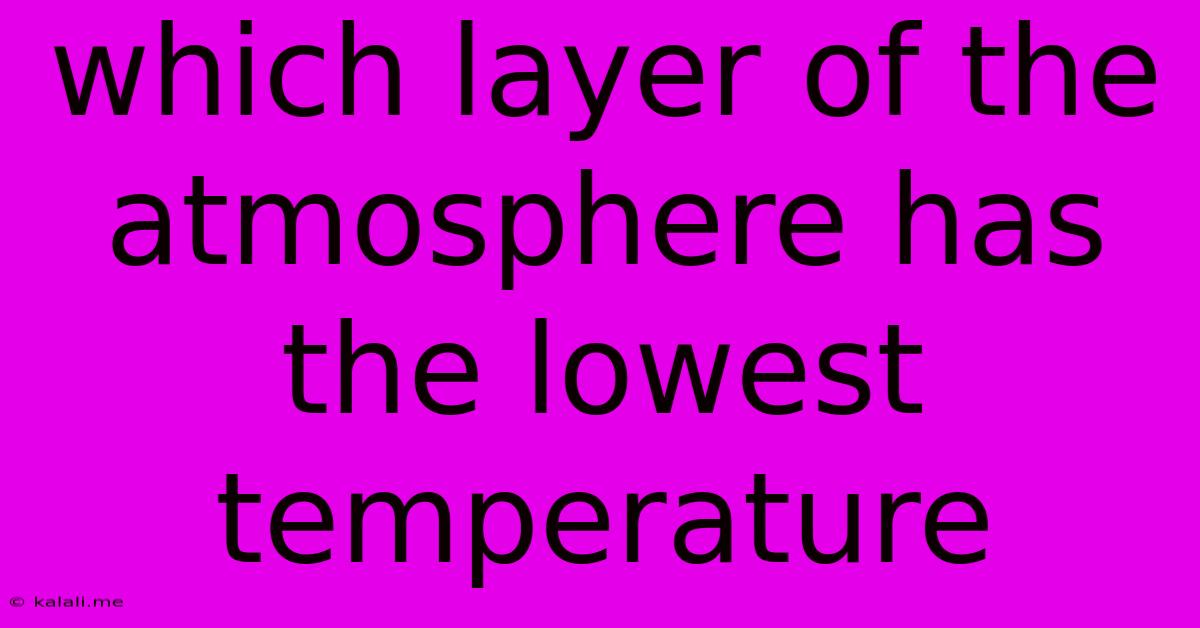Which Layer Of The Atmosphere Has The Lowest Temperature
Kalali
Jun 16, 2025 · 3 min read

Table of Contents
Which Layer of the Atmosphere Has the Lowest Temperature? A Deep Dive into Atmospheric Temperatures
The Earth's atmosphere is a complex system, divided into distinct layers, each with its own unique characteristics. One of the most fascinating aspects of these layers is their temperature profiles. Understanding which layer boasts the lowest temperatures is key to comprehending atmospheric dynamics and overall climate science. So, which layer holds the record for the coldest temperatures? The answer might surprise you. This article delves into the different layers of the atmosphere and reveals the coldest one.
Understanding Atmospheric Layers and Temperature Gradients
Before we pinpoint the coldest layer, let's briefly review the major layers of the atmosphere:
- Troposphere: This is the layer closest to the Earth's surface, where weather phenomena occur. Temperature generally decreases with altitude in this layer.
- Stratosphere: Above the troposphere, the stratosphere contains the ozone layer, which absorbs harmful ultraviolet radiation from the sun. Temperature increases with altitude in the stratosphere due to ozone absorption.
- Mesosphere: The mesosphere is characterized by a decrease in temperature with increasing altitude. This layer experiences the coldest temperatures in the entire atmosphere.
- Thermosphere: The thermosphere is incredibly hot, though it wouldn't feel that way. The temperature rises sharply here, but the air is extremely thin. "Heat" is defined by the kinetic energy of molecules; there are so few molecules in the thermosphere that the total heat energy is low despite the high temperatures.
- Exosphere: This is the outermost layer, where the atmosphere gradually merges with space.
The Coldest Layer: The Mesosphere
The layer with the lowest temperature is the mesosphere. Temperatures in the mesosphere can plummet to as low as -90°C (-130°F), or even colder. This extreme cold is a result of the decreasing concentration of gases absorbing solar radiation.
Several factors contribute to the mesosphere's frigid temperatures:
- Reduced absorption of solar radiation: Unlike the stratosphere, where ozone absorbs UV radiation and heats the layer, the mesosphere has a significantly lower concentration of gases to absorb solar energy.
- Carbon dioxide cooling: While carbon dioxide is a greenhouse gas, its radiative cooling effects are more pronounced at higher altitudes, contributing to the cold temperatures in the mesosphere.
- Distance from the Earth's surface: The mesosphere's distance from the Earth's surface minimizes the effect of heat radiated from the planet.
Why the Thermosphere isn't the coldest despite high temperatures
While the thermosphere has extremely high temperatures, it's crucial to understand that these are kinetic temperatures—a measure of the average speed of the gas molecules. The incredibly low density of the thermosphere means there are very few molecules present, even though each molecule moves very fast. Therefore, even though the temperature is high, there's not much heat to be transferred.
Conclusion:
In conclusion, while the thermosphere experiences high temperatures, the mesosphere holds the title of the coldest layer in the Earth's atmosphere, with temperatures reaching extraordinarily low levels. Understanding these temperature variations across different atmospheric layers is crucial for comprehending Earth's climate system and various atmospheric phenomena. Further research continues to refine our understanding of these complex interactions.
Latest Posts
Latest Posts
-
How To Create Clickable Image In Html
Jun 16, 2025
-
What Are The Factors Of 121
Jun 16, 2025
-
What Is A Theme Of The Passage
Jun 16, 2025
-
A Company That Provides Access To The Internet
Jun 16, 2025
-
Which Word Is Closest In Meaning To The Underlined Word
Jun 16, 2025
Related Post
Thank you for visiting our website which covers about Which Layer Of The Atmosphere Has The Lowest Temperature . We hope the information provided has been useful to you. Feel free to contact us if you have any questions or need further assistance. See you next time and don't miss to bookmark.